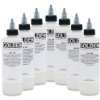Can I use watercolor paint for sun painting fabric?
Name: Gail
—ADVERTISEMENT—
Sun Paint: Use Sunshine to Make Colorful Fabric Prints with Other and Paint Brush and PaintA Klutz book
by Barbara Kane

Pebeo Setacolor Transparent Fabric Paint

Setacolor Transparent is just one of many transparent fabric paints that can be used for sun printing.
Country or region: Colorado
Message: Re: Sun painting.... I do water color and was wondering if I use watercolor paint (student brands due to cost) if this would work for sun painting. I have considered the setacolors but they are so expensive and I would use then very little. Would mixing dye to a paste with the sodium agate (?) work just as well? I find I am a fabric dyer and not a fabric painter.
In sun painting, a thin transparent fabric paint is applied to fabric (usually damp fabric) that has been stretched on a frame or a piece of card or plastic; small objects are scattered on top of the painted fabric; finally, the whole is exposed to bright sunlight or a hot halogen lamp. As the paint dries in the sun-exposed areas, the pigment tends to migrate out of covered areas into the exposed areas, leaving lighter "shadows" of whatever objects were placed on the painted fabric.
Do not use watercolor paint on any fabric that you will ever want to wash. Watercolor paint will work for you only if you do not subject it to laundering. It would be disappointing to see your work gone after only a couple of trips through the washer. If you're not coloring wearables, most transparent watercolor paint will work for sun painting on thin fabric, assuming that your fabric will never be allowed to get wet again after you are done.
Sodium alginate is a thickener for dye or paints, but it does nothing to permanently attach a pigment to the fabric. For sun painting, you want your paint to be thin, not thickened at all, so you should never use sodium alginate in your paint when sun painting.
If you don't mind the harsh feel, then heavily diluted acrylic paint, such as Liquitex Soft Body Artist Acrylics, could be used for sun painting. If diluted with sufficient water and used on wet, tightly stretched fabric, acrylic paint will generally be able to perform in sunpainting. If you allow acrylic paint to dry on fabric for a long time, say for a month, and then press it with a hot iron, it will be reasonably resistant to being washed off in the laundry (always be sure to turn garments inside-out before washing, to reduce wear). There are two drawbacks to using artists' acrylics in place of fabric paint: one is that the paint feels much harsher to your skin than fabric paint, after it dries, and the other is that it can be more difficult to get it to adhere to the fabric.
The best way to use artists' acrylics as fabric paint is to buy some fabric medium, such as Golden GAC 900 Fabric Medium or Liquitex Fabric Medium, and mix it with the paint to make your own fabric paint. The fabric medium improves the feel of the paint after it dried, and helps it to soak into the fabric. You might be able to find fabric medium in your local art supply store; if not, you will have to mail-order it. I think that ordering fabric medium is as much trouble as just ordering fabric paint to begin with, but it will allow you to mix whatever quantity you need of any color you like. Be sure that you choose a product specifically labeled "fabric medium" or "textile medium"; there are many other types of acrylic media, but none of the others will work for turning acrylic paint into fabric paint.
Setacolor is not the only pre-mixed fabric paint that will work for sun painting. Any thin, transparent fabric paint should work. Setacolor is one option. Other well-tested options include Jacquard Dye-Na-Flow, PRO Chemical & Dye's PROfab textile paints, or really any thin fabric paint that is not opaque. Of course you will want to avoid metallic, pearlescent, slick, or puffy fabric paint. It's a good idea to do a small test with one color before investing in several colors of an unfamiliar brand of transparent fabric paint for a sun-printing project.
Also see my page, "How to Dye and Paint Fabric with Light", for more information about sun painting.
(Please help support this web site. Thank you.)
Posted: Tuesday - July 02, 2013 at 08:19 AM
Follow this blog on twitter here.
- Top of this blog -
- FAQ -
- The Dye Forum -
- How to Tie Dye - How to Batik -
- Books - Toys - Plants -
More in this category:
- -
Total entries in this category:
Published On: Jul 02, 2013 09:06 AM
